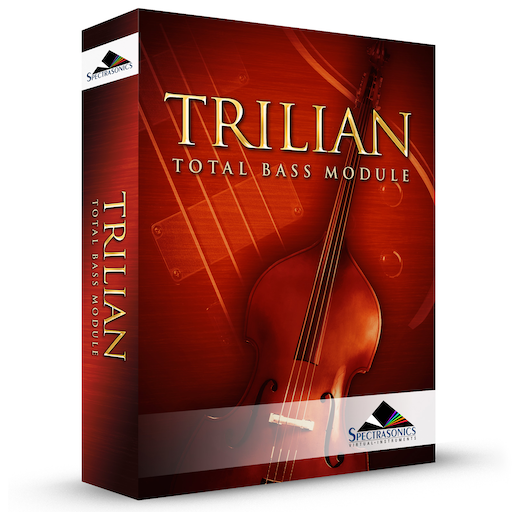
A Modulation Target is a parameter that can be controlled by a source. “Target” is another word for “Destination.” Trilian has an extensive set of nearly fifty different modulation targets available. They are grouped into six categories:
Oscillator
- Pitch Coarse – The coarse tuning of the oscillator’s pitch (polyphonic)
- Pitch Fine – The fine-tuning of the oscillator’s pitch (polyphonic)
- FM Frequency – The frequency of the dedicate FM modulator (polyphonic)
- FM Depth – The depth of the FM modulator (polyphonic)
- Harmonia Mix – The blend of the Harmonia voices with the primary Oscillator (polyphonic)
- Harmonia Level 1 – The level of the first Harmonia oscillator (monophonic)
- Harmonia Level 2 – The level of the second Harmonia oscillator (monophonic)
- Harmonia Detune 1 – The detune amount of the first Harmonia oscillator (monophonic)
- Harmonia Detune 2 – The detune amount of the second Harmonia oscillator (monophonic)
- Sample Timbre – The Sample Timbre parameter in the Oscillator (polyphonic)
- Sample Start – The Sample Start parameter in the Oscillator (polyphonic)
Filter
- Cutoff – The Filter’s cutoff frequency (polyphonic)
- Resonance – The Filter’s Resonance amount (polyphonic)
- Filter Mix – The mix between Filter1 and Filter2 (monophonic)
- Spread – The Filter’s Spread control value (monophonic)
- Filter 1 Cutoff Offset – The Filter 1 cutoff offset value (monophonic)
- Filter 2 Cutoff Offset – The Filter 2 cutoff offset value (monophonic)
- Filter 1 Res Offset – The Filter 1 Resonance offset (monophonic)
- Filter 2 Res Offset – The Filter 2 Resonance offset (monophonic)
- Filter 1 Spread – The Filter 1 spread (monophonic)
- Filter 2 Spread – The Filter 2 spread (monophonic)
Amp
- Amplitude *** – The amplitude level (polyphonic)
- Pan – The stereo panning control (polyphonic)
LFO
- LFO1 Rate – The speed of LFO1 (monophonic)
- LFO1 Depth – The amount of LFO1 (monophonic)
- LFO2 Rate – The speed of LFO2 (monophonic)
- LFO2 Depth – The amount of LFO2 (monophonic)
- LFO3 Rate – The speed of LFO3 (monophonic)
- LFO3 Depth – The amount of LFO3 (monophonic)
- LFO4 Rate – The speed of LFO4 (monophonic)
- LFO4 Depth – The amount of LFO4 (monophonic)
- LFO5 Rate – The speed of LFO5 (monophonic)
- LFO5 Depth – The amount of LFO5 (monophonic)
- LFO6 Rate – The speed of LFO6 (monophonic)
- LFO6 Depth – The amount of LFO6 (monophonic)
Envelope
- Amp Env Attack Trim *** – The relative AMP Attack time (polyphonic)
- Amp Env Decay Trim *** – The relative AMP Decay time (polyphonic)
- Amp Env Release Trim *** – The relative AMP Release time (polyphonic)
- Amp Env Speed – The speed of the Amplitude Envelope
- Filter Env Attack Trim *** – The relative Filter Attack time (polyphonic)
- Filter Env Decay Trim *** – The relative Filter Decay time (polyphonic)
- Filter Env Release Trim *** – The relative Filter Release time (polyphonic)
- Filter Env Depth – The amount of the Filter Envelope
- Filter Env Speed – The speed of the Filter Envelope (monophonic)
- Mod Env1 Depth – The amount of Mod Envelope1 (monophonic)
- Mod Env1 Speed – The speed of Mod Envelope1 (monophonic)
- Mod Env2 Depth – The amount of Mod Envelope2 (monophonic)
- Mod Env2 Speed – The speed of Mod Envelope2 (monophonic)
Morphing Modulation
- Morphing Input A – Explained in the Morphing Modulation section
- Morphing Input B – Explained in the Morphing Modulation section
- Morphing Input A/B Xfade – Explained in the Morphing Modulation section (monophonic)
(***) These parameters appear exclusively within the Modulation Matrix and are not seen on the GUI.
NOTE: The following Modulation Targets appear on the Target list, but are greyed-out and not accessible from within Trilian. They are there for compatibility with Omnisphere’s Library Integration feature.
- Unison Detune – The amount of detuning of Oscillator unison voices (monophonic)
- Unison Depth – The amount of Oscillator Unison voices added (monophonic)
- Ring Mod Frequency – The frequency of the Ring modulator (polyphonic)
- Ring Mod Depth – The amount of Ring Modulation (polyphonic)
- Waveshaper Depth – The amount of Oscillator Waveshaping (polyphonic)
- Waveshaper Mix – The blend of the waveshaping signal (polyphonic)
- Sample Granular Intensity – The size/intensity of the sample grains (monophonic)
- Sample Pitch Grains – The probability of Granular pitch grains (monophonic)
- Synth Shape – The Synth Oscillator’s shape (polyphonic)
- Synth Hard Sync – The Synth Oscillator’s Hard Sync (polyphonic)
- Synth Symmetry – The Synth Oscillator’s Symmetry (polyphonic)
- Synth Phase – The Synth Oscillator’s Phase control (polyphonic)
- Synth Analog – The Synth Oscillator’s Analog control (polyphonic)
Need more help with this?
Spectrasonics Customer Support



